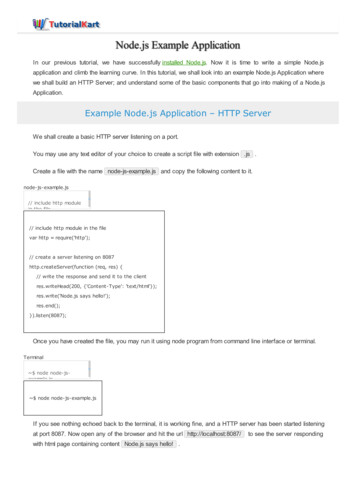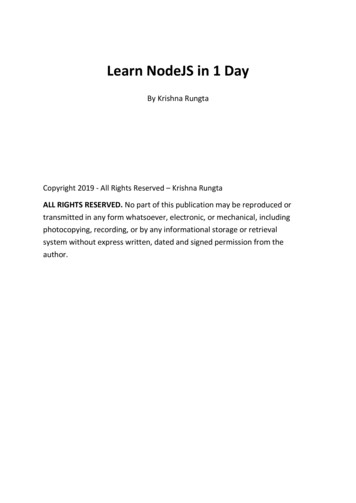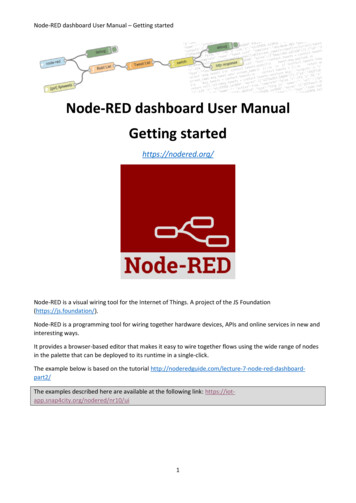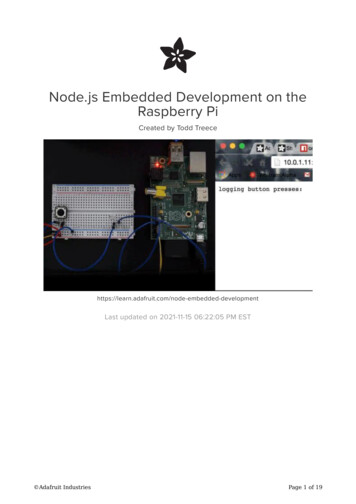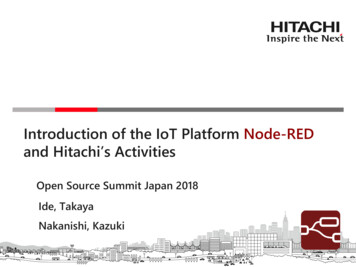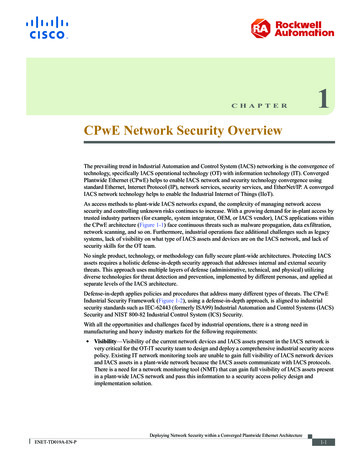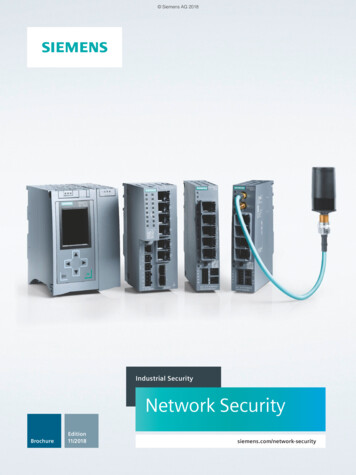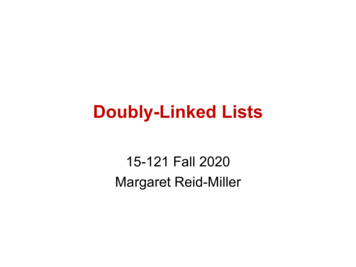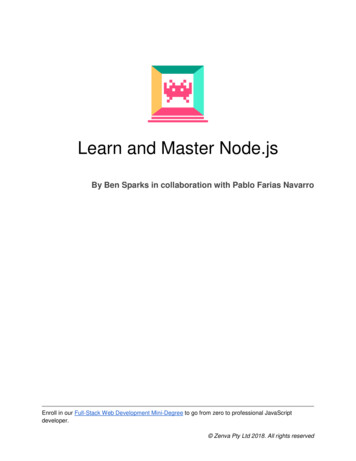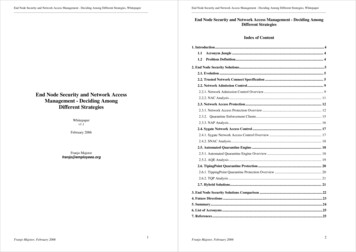
Transcription
End Node Security and Network Access Management - Deciding Among Different Strategies, WhitepaperEnd Node Security and Network Access Management - Deciding Among Different Strategies, WhitepaperEnd Node Security and Network Access Management - Deciding AmongDifferent StrategiesIndex of Content1. Introduction.41.1Acronym Jungle . 41.2Problem Definition. 42. End Node Security Solutions.52.1. Evolution . 52.2. Trusted Network Connect Specification . 52.2. Network Admission Control. 92.2.1. Network Admission Control Overview . 9End Node Security and Network AccessManagement - Deciding AmongDifferent Strategies2.2.2. NAC Analysis . 112.3. Network Access Protection . 122.3.1. Network Access Protection Overview . 122.3.2. Quarantine Enforcement Clients. 15Whitepaper2.3.3. NAP Analysis. 16v1.12.4. Sygate Network Access Control . 17February 20062.4.1. Sygate Network Access Control Overview . 172.4.2. SNAC Analysis. 182.5. Automated Quarantine Engine . 18Franjo Majstorfranjo@employees.org2.5.1. Automated Quarantine Engine Overview. 182.5.2. AQE Analysis . 192.6. TipingPoint Quarantine Protection . 202.6.1. TippingPoint Quarantine Protection Overview . 202.6.2. TQP Analysis . 212.7. Hybrid Solutions. 213. End Node Security Solutions Comparison .224. Future Directions .235. Summary.246. List of Acronyms .257. References .25Franjo Majstor, February 20061Franjo Majstor, February 20062
End Node Security and Network Access Management - Deciding Among Different Strategies, WhitepaperEnd Node Security and Network Access Management - Deciding Among Different Strategies, WhitepaperIndex of Exhibits1. IntroductionExhibit 1: Trusted Network Connect Architecture .61.1Acronym JungleExhibit 2: Layered Trusted Network Connect Architecture .7Exhibit 3: TNC Architecture with Provisioning and Remediation Layer.8Exhibit 4: Network Admission Control Architecture Components .10Exhibit 5: NAC End Node Protocol Stack.11Exhibit 6: NAC Access Control Flow .12Exhibit 7: Network Access Protection Architecture.13Like almost in any industry, in the networking industry there are far too many technicalacronyms. Security terminology is unfortunately not immune to that neither, and combinedsecurity terms with networking terms resulted in almost catastrophic amount ofacronyms together and is most probably not going to be in the future neither. Therefore, anadvance apology is given to beginner readers of this chapter with a recommendation to checkthe references and whenever reading one of the new terms in the latest "acronym jungle", tojump to an end of the article, where all acronyms are spelled out at one place.Exhibit 8: Interaction between Network Access Protection Components .14Exhibit 9: NAP Client Architecture .16Exhibit 10: SNAC Solution Overview.18Exhibit 11: Automated Quarantine Engine from Alcatel .19Exhibit 12: TippingPoint Quarantine Protection Action Steps.20Exhibit 13: Private VLAN (PVLAN) Operation .21Exhibit 14: End Node Security Solutions Comparison Table-1 .22Exhibit 15: End Node Security Solutions Comparison Table-2 .231.2Problem DefinitionIt would be easy, if acronyms would be the only problem. Nowadays, modern networks areamongst the others responsible for employee productivity, product manufacturing, receivingorders from customers and as such are business-critical systems that are, if not available orunder attack, resulting in a denial of service, theft of sensitive information or exposure toregulatory penalties. Traditional perimeter-focused security architectures are today powerlessagainst the infected endpoints that connect to enterprise networks from various differentlocations. Information security practitioners are dealing almost on daily basis with situationslike the following. Sales persons when on the road frequently connects to an insecure hotelnetwork or other public Internet service where their laptops could get exposed to a malwareinfection. Enterprise information technology departments have defined policies and equippedthe salesperson’s laptop with protections such as the latest Anti-Virus software, personalfirewalls, host intrusion prevention, operating system configurations, and patches to protectthe system against compromise. Unfortunately, those protections can be turned off,uninstalled, or may simply have never been updated to the laptop, leaving the salesperson’scomputer unprotected. Company guests and visitors would often use offered hospitality toconnect via internal enterprise wired or wireless network to the Internet. Their portableequipment could in case they are not up to speed with a latest viral protection, be alreadycompromised and as such could cause the compromise to the rest of the network resourcesthey are connecting through.These are just two examples out of the many and reality in the latest vulnerability statistics ofthe most popular computing equipment software platforms shows us that most of the time anunintentional user or guest visitor network usage caused an avalanche of problems to the restof the network resources that are crucial for running the business.Several initiatives started from the industry vendors and organizations have already addressedsome problems of the individual endpoint security with applications like anti-virus agents andpersonal firewalls, while the connectivity of the end node to the network infrastructure gotalready a while ago the end node authentication via 802.1x protocol. However all of thosemechanisms individually have been proven not to be sufficient to stop problems of thenetwork resources under a threat so far. Hence, a group of solution efforts from the leadingFranjo Majstor, February 20063Franjo Majstor, February 20064
End Node Security and Network Access Management - Deciding Among Different Strategies, Whitepapermarket vendors as well as standardization organizations came out with several individualsolutions to address the burning issue of both - integrity and policy compliancy of the endnode towards accepted rules of behavior from the network infrastructure. Informationsecurity practitioners that are already today and will be even more in the future exposed to anend node to an infrastructure interaction problem, should be able to understand the essence ofthe issue and be capable to find a proper end node to infrastructure interactivity securitymechanism that would fit their business environment.End Node Security and Network Access Management - Deciding Among Different Strategies, Whitepaper3) Access Policy: ensuring that the endpoint machine and/or its user authenticates andestablishes their level of trust before connecting to the network, leveraging a number ofexisting and emerging standards, products, or techniques.4) Assessment, Isolation and Remediation: ensuring that endpoint machines not meeting thesecurity policy requirements for ‘trust’ can be isolated or quarantined from the rest of thenetwork, and if possible an appropriate remediation applied, such as upgrading software orvirus signature databases to enable the endpoint to comply with security policy and becomeeligible for connection to the rest of the network.2. End Node Security SolutionsBasic TNC Architecture is illustrated in Exhibit 1.2.1. EvolutionInitiatives to solve the end node causing availability, integrity and confidentiality problems tothe rest of the network started by several combined vendor solutions, so no wonder thatnetworking vendor, Cisco Systems as well as operating system vendor Microsoft came withtheir unique proposals. Several other end node antiviral software vendors joined theinitiatives of both, while some other created their own solutions. Overall it has created thepanache of closed efforts on the market locking the choice around the particular vendorsolution. To move out of the closed group proposals, the Trusted Computing Group (TCG)organization of vendors came out with Trusted Network Connect (TNC) specification thatdescribes the problem and gives the framework for the vendor interoperable solution. Even itcame as an umbrella answer solution later, it well explains the detailed individualcomponents of the system with their roles and functions, so it is the best to start with itexplaining the concept of the future end node security solutions.2.2. Trusted Network Connect SpecificationThe TNC architecture and specifications were developed with a purpose of ensuring theinteroperability amongst the individual components for the solution provided by differentvendors. The aim of the TNC architecture is to provide a framework within which consistentand useful specifications can be developed to achieve a multi-vendor network standard thatprovides the following four features:1) Platform Authentication: the verification of a network access requestor’s proof of identityof their platform and the integrity-status of that platform.2) Endpoint Policy Compliance (Authorization): establishing a level of ‘trust’ in the state ofan endpoint, such as ensuring the presence, status, and upgrade level of mandatedapplications, revisions of signature libraries for anti-virus and intrusion detection andprevention system applications, and the patch level of the endpoint’s operating system andapplications. Note that policy compliance can also be viewed as authorization, in which anendpoint compliance to a given policy set result in the endpoint being authorized to gainaccess to the network.Franjo Majstor, February 20065AccessRequestor(AR)PolicyDecision Point(PDP)PolicyEnforcementPoint (PEP)Exhibit 1: Trusted Network Connect ArchitectureThe entities within the architecture are: Access Requestor (AR), Policy Enforcement Point(PEP) and Policy Decision Point (PDP).1. Access Requestor (AR): The AR is the entity seeking access to a protected network.2. Policy Decision Point (PDP): The PDP is the entity performing the decision-makingregarding the AR’s request, in light of the access policies.3. Policy Enforcement Point (PEP): The PEP is the entity that enforces the decisions of thePDP regarding network access.All entities and components in the architecture are logical ones, not physical ones. An entityor component may be a single software program, a hardware machine, or a redundant andreplicated set of machines spread across a network, as appropriate for its function and for thedeployment’s needs. Entities of the TNC Architecture are structured in the layers. LayeredTNC Architecture levels that are illustrated in Exhibit 2 are the following:1. The network access layer: Components whose main function pertains to traditional networkconnectivity and security. Even thought the name might that imply, this layer does not referto OSI network layer only but may support a variety of modern networking accesstechnologies like switch port or wireless, as well as VPN access or firewall access.2. The integrity evaluation layer: The components in this layer are responsible for evaluatingthe overall integrity of the Access Requestor with respect to certain access policies.Franjo Majstor, February 20066
End Node Security and Network Access Management - Deciding Among Different Strategies, WhitepaperEnd Node Security and Network Access Management - Deciding Among Different Strategies, Whitepaper3. The integrity measurement layer: This layer contains plug-in components that collect andverify integrity-related information for a variety of security applications on the AccessRequestor.Requestor (AR) should be granted access. The NAA may consult a TNC Server to determinewhether the AR's integrity measurements comply with the NAA's security policy. In manycases, an NAA will be an AAA server such as RADIUS server, but this is not required.And a third entity of the TNC Architecture that sits in the middle of the AR and a PDP is thePolicy Enforcement Point (PEP) that consists of the following components: Policy Enforcement Point (PEP): The PEP is a typically the hardware component thatcontrols access to a protected network. The PEP consults a PDP to determine whether thisaccess should be granted. An example of the PEP is the Authenticator in 802.1x, which isoften implemented within the 802.11 wireless access point. It could also be an 802.1x enabledswitch port or a firewall as well as the VPN gateway.Although not visibly evident within the TNC Architecture, one important feature of thearchitecture is its extensibility and support for the isolation and remediation of ARs, which donot succeed in obtaining network access permission due to failures in integrity verification.TNC Architecture with Provisioning and Remediation Layer that is illustrated in Exhibit 3shows an additional layer addressing remediation and provisioning.Exhibit 2: Layered Trusted Network Connect ArchitectureThe Access Requestor (AR) consists of the following components: Integrity Measurement Collector (IMC): The IMC is a component of an AR that measuressecurity aspects of the AR's integrity. Examples include the Anti-Virus parameters on theAccess Requestor, personal firewall status, software versions, and others. The TNCArchitecture accommodates implementation situations where multiple IMCs reside on asingle AR, catering for corresponding different applications. TNC Client (TNCC): The TNCC is a component of an AR that aggregates integritymeasurements from multiple IMCs and assists with the management of the Integrity CheckHandshake for the purpose of measurement and reporting of the AR integrity. Network Access Requestor (NAR): The NAR is the component responsible for establishingnetwork access. The NAR can be implemented as a software component that runs on an AR,negotiating its connection to a network. There may be several NARs on a single AR to handleconnections to different types of networks. One example of a NAR is the supplicant in802.1x, which is often implemented as software on a client system or could be VPN clientsoftware as well.The Policy Decision Point (PDP) consists of the following components:Exhibit 3: TNC Architecture with Provisioning and Remediation Layer Integrity Measurement Verifier (IMV): The IMV is a component that verifies a particularaspect of the AR’s integrity, based on measurements received from IMCs and/or other data. TNC Server (TNCS): The TNCS is a component that manages the flow of messages betweenIMVs and IMCs, gathers IMV action recommendations from IMVs, and combines thoserecommendations (based on policy) into an overall TNCS action recommendation to theNAA. Network Access Authority (NAA): The NAA is a component that decides whether an AccessFranjo Majstor, February 20067In order to understand the actions needed to remedy ARs that fail integrity verification, it isuseful to view network connection requests in three basic phases from the perspective ofintegrity verification:1. Assessment: In this phase, the IMVs perform the verification of the AR following thepolicies set by the network administrator and optionally deliver remediationinstructions to the IMCs.Franjo Majstor, February 20068
End Node Security and Network Access Management - Deciding Among Different Strategies, Whitepaper2. Isolation: If the AR has been authenticated and is recognized to be one that has someprivileges on the network but has not passed the integrity-verification by the IMV, thePDP may return instructions to the PEP to redirect the AR to an isolation environment wherethe AR can obtain integrity-related updates. Isolation environment mechanisms could be:End Node Security and Network Access Management - Deciding Among Different Strategies, WhitepaperAnti-Virus vendors with a goal to isolate the most burning problem at a time - stop the virusand worm infection from infected hosts at their network connection points. NAC architectureachieves that by checking the end node security compliancy before admitting it to connect tothe network.Security policy compliance checks that NAC can perform include:(a) VLAN Containment: VLAN containment permits the AR to access the network in alimited fashion typically for the purpose of the limited access and to allow the AR toaccess on-line sources of remediation data (e.g. virus definition file updates, wormremoval software, software patches, etc).(b) IP Filters: In the case of IP filters, the PEP is configured with a set of filters whichdefines network locations reachable by the isolated AR. Packets from the AR destinedto other network locations are simply discarded by the PEP.3. Remediation: Remediation is the process of the AR obtaining corrections to its currentplatform configuration and other policy-specific parameters in order to bring it inline with thePDP’s requirements for network-access.The remediation process requires remediation provisioning application and resources that canbe implemented in several forms. For example, that would be the Anti-Virus applicationsoftware that communicates with sources of Anti-Virus parameters (e.g. latest AV signaturefiles) or could be an agent that updates the latest patches from the ftp server that contains thelatest patches. Note that in the current TNC Architecture document, remediation is out ofscope and is treated briefly only for completeness.Although integrity measurement and reporting is core to the value proposition of the TNCphilosophy and approach, the TNC Architecture acknowledges other networking technologiesas providing the infrastructure support surrounding the core elements of the TNCArchitecture. Note that the TNC specification is not standardizing specific protocol bindingsfor these technologies but is rather defining only layer interfaces (as seen on the TNCArchitecture Exhibit with an appendix IF- ) and is relaying on already existing protocols,such as 802.1x, IPsec/IKE, PEAP, TLS for network access or RADIUS and DIAMETER forcommunication with and within PDP. Determining whether the device is running an authorized version of an operating system. Checking to see if the OS has been properly patched, or has received the latest hotfix. Determining if the device has Anti-Virus software installed, and whether it has the latestset of signature files. Ensuring that Anti-Virus technology is enabled and has been recently run. Determining if personal firewall, intrusion prevention, or other desktop security softwareis installed and properly configured. Checking whether a corporate image of a device has been modified or tampered with.NAC architecture components that are illustrated in Exhibit 4 are:HostsAttemptingNetwork AccessNetwork AccessDeviceAntiVirusclientCiscoSecurityAgent3rd PartyAgentCisco PolicyServerAV Policy Serveror 3rd party PolicyServer SolutionsSecurity Credential CheckingCiscoTrustAgentSecurity PolicyEnforcementSecurity PolicyCreationEndpoint PolicyEvaluationExhibit 4: Network Admission Control Architecture ComponentsEven though that up to the moment of writing this chapter there was no commerciallyavailable nor widely deployed solution implementation based on TNC specification, TNCdetailed architecture components description represent an open framework for vendor neutralsolution where multiple vendors could provide an individual modules of the complete endnode security solution. Several individual vendor or vendor alliances that have inspired theTNC specification work are described going further. Endpoint Security Software - NAC solution requires either Cisco Trust Agent or a thirdparty software agent that is capable of executing the integrity checks on the end node andcommunicating that during the network access request phase. Network Access Device - a network access device like router, switch, VPN gateway, orfirewall that can demand endpoint security “credentials” from the endpoint. This is in TNCterminology analogy of a Policy Enforcement Point.2.2. Network Admission Control Policy/AAA Server - RADIUS server that evaluates endpoint security credentials relayedfrom the network access device and determine the appropriate access policy (permit, deny,quarantine, restrict) to be applied back to the network access device for the particular endnode accessing the network.2.2.1. Network Admission Control OverviewNetwork Admission Control (NAC) architecture is an industry effort lead by Cisco Systems,that initially started as an interoperable framework between networking vendor and severalFranjo Majstor, February 20069 Anti-Virus Policy Server - third party server that evaluates particular policy like Anti-Viruspolicy. As NAC solution includes multiple vendors, third party policy servers could be usedto check integrity of any application running on the end node system as well as hardwareFranjo Majstor, February 200610
End Node Security and Network Access Management - Deciding Among Different Strategies, WhitepaperEnd Node Security and Network Access Management - Deciding Among Different Strategies, Whitepapercomponents compliancy, however they need to interfaces to policy/AAA server that is undercontrol of Cisco Systems and even though there is a plan to open and standardize it, that isstill remaining to happen.compliancy messages exchange could happen even before the IP address is obtained. NACcommunication flow is illustrated in Exhibit 6.2.2.2. NAC AnalysisEven though that Endpoint Security Software of a NAC architecture uses standardcommunication protocols between the agent components and even that the interface softwareis provided free of charge by Cisco Systems, exchange of “security credentials”, as CiscoSystems refers to an end node integrity state check, is still not standardized. Standards-basedtechnologies that are used are EAP, 802.1x, and RADIUS. In some cases, these technologiesmay need to accommodate specific enhancements to support the NAC solution. CiscoSystems expects to drive adoption of these enhancements through appropriate standardsbodies.The Cisco Trust Agent, Endpoint Security Software available from Cisco Systems, collectssecurity state information from the operating system and multiple security software clients,such as Anti-Virus and Cisco Security Agent software clients, and communicates thisinformation to the connected network, where access control decisions are enforced. TheCisco Trust Agent that has the closest equivalent role of the TNCC in the TNC Architecturehas in the NAC architecture following three main rkAccessDevicesPolicy RightsNotific ation46AVServerHTTPSRADIUSEAP/UDP,EAP/802.1xCisco orcement Network Communications-Respond to network requests for application and operatingsystem information such as Anti-Virus and operating system patch details. Security Model-Authenticate the application or device requesting the host credentials andencrypt that information when it is communicated Application Broker-Through an API, enables numerous applications to respond to state andcredential requestsAVCSAAnyEAP/TLV APIBroker & SecurityComms: L2/3 ServiceEAP/UDPEAP/802.1xExhibit 5: NAC End Node Protocol StackEnd node protocol stack that is illustrated in Exhibit 5, shows several layers of an end nodeagent security software. Cisco Systems decided, for most probably faster time to market, toimplement EAP over UDP protocol exchange first. EAP over UDP made NAC solutionimmediately available to work on the layer 3. That helped to nodes with an IP address that tryto connect to the rest of the layer three network infrastructure to exchange EAP messageswith the infrastructure and based on the overall exchange, get access to the network resourcesgranted or not granted. In essence router from Cisco Systems, as the very firstimplementation phase of NAC architecture solution, understands EAP over UDP controlmassages and does EAP messages exchange with a Endpoint Security Software and PolicyServer. Follow up phases brought the EAP over layer 2 that allowed NAC communication tonetwork devices such as switches or wireless access points where authentication and policyFranjo Majstor, February 2006115Exhibit 6: NAC Access Control FlowPolicy enforcement actions are directly dependent on the communication method between theend node software agent and the network node and were initially only permit, deny orquarantine access via simple layer 3 router access control list filter, while follow up phasesintroduced VLAN isolation too.Both layer 2 and layer 3 end nodes which demand network access as well as network accessdevices themselves in the NAC solution would need to be up to date with a compatiblesoftware release to be a valid member of the NAC solution. In the mean time Cisco Systemsalso introduced the NAC appliances family of products, but its significance stays as one ofthe first integrity network access control implementers on the market. The NAC architecturebrought an innovative break through in the capability that network access devices couldpolice the state of the end node and make an intelligent decision before connecting it to therest of the network, so no wonder that Cisco Systems leverage it as a crucial part of its SelfDefending Network strategy.2.3. Network Access Protection2.3.1. Network Access Protection OverviewNetwork Access Protection (NAP) solution coming from Microsoft next generation Windowsserver with a code name "Longhorn", provides policy enforcement components that help ensurethat computers connecting to a network or communicating on a network meet administratordefined requirements for system health. NAP uses a combination of policy validation andFranjo Majstor, February 200612
End Node Security and Network Access Management - Deciding Among Different Strategies, WhitepaperEnd Node Security and Network Access Management - Deciding Among Different Strategies, Whitepapernetwork isolation components to control network access or communication. It can alsotemporarily isolate computers that do not meet requirements to a restricted network. Dependingon the configuration chosen, the restricted network might contain resources required to updatethe computers so that they then meet the health requirements for full network access or normalcommunication. When it will be available for deployment, NAP will be able to create solutionsfor health policy validation, isolation, and ongoing health policy compliance. VPN Quarantine consists of a VPN QES component and a VPN QEC component. UsingVPN Quarantine, VPN servers with VPN QEC component could enforce health policyrequirements any time a computer attempts to make a Layer 2 Tunneling Protocol (L2TP)VPN connection to the network. VPN Quarantine provides strong network isolation for allcomputers a
Access Requestor, personal firewall status, software versions, and others. The TNC Architecture accommodates implementation situations where multiple IMCs reside on a single AR, catering for corresponding different applications. TNC Client (TNCC) : T
